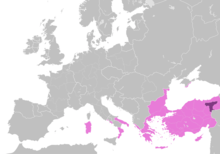Koloneia (theme)
The Theme of Koloneia (Greek: θέμα Κολωνείας) was a small military-civilian province (thema or theme) of the Byzantine Empire located in northern Cappadocia and the southern Pontus, in modern Turkey. It was founded sometime in the mid-9th century and survived until it was conquered by the Seljuk Turks soon after the Battle of Manzikert in 1071.
| Theme of Koloneia Κολωνεία, θέμα Κολωνείας | |
|---|---|
| Theme of the Byzantine Empire | |
| before 863 – after 1071 | |
 Map of the Theme of Koloneia within the Byzantine Empire in 1000 AD. | |
| Historical era | Middle Ages |
• Established | before 863 |
• Fall to the Seljuks. | after 1071 |
| Today part of | |
History
Originally part of the Armeniac Theme, the theme was formed around the city of Koloneia on the river Lykos (modern Şebinkarahisar).[1] The theme is attested for the first time in 863,[1][2][3] but it apparently existed as a separate district earlier: Nicolas Oikonomides interprets a reference by the Arab geographer al-Masudi to mean that it constituted first a kleisoura (a fortified frontier district).[4][2] In addition, a version of the Life of the 42 Martyrs of Amorium mentions that Emperor Theophilos (r. 829–842) appointed a certain spatharios Kallistos as its doux in circa 842, making it the likely date of its elevation to a full theme (alongside neighbouring Chaldia).[1][3][4]
Koloneia's remote location preserved it from the worst of the Arab raids, except for a major raid by Sayf al-Dawla in 939/940. In 1057, the local regiment, under Katakalon Kekaumenos, supported the uprising of Isaac I Komnenos. In 1069, the theme was occupied by the rebel Norman mercenary Robert Crispin. The region fell to the Seljuk Turks soon after the Battle of Manzikert in 1071.[1][5]
Location
In the De Thematibus, Emperor Constantine VII Porphyrogennetos (r. 913–959) describes the theme as a small circumscription, encompassing, aside from Koloneia, Neocaesarea in the east, Arabraca, Mount Phalakros (probably modern Karaçam Dağı), Nicopolis and Tephrike. It also comprised sixteen unnamed fortresses.[3][4] Porphyrogennetos also records that his father, Leo VI the Wise (r. 886–912), separated the tourma of Kamacha from Koloneia to form (along with Keltzene) the new theme of Mesopotamia.[6]
References
- ODB, "Koloneia 1. Koloneia on the Lykos in interior Pontos" (C. Foss), p. 1138.
- Oikonomides 1972, p. 349.
- Pertusi 1952, pp. 141–142.
- Bryer & Winfield 1985, p. 147.
- Bryer & Winfield 1985, pp. 147–148.
- ODB, "Kamacha" (C. Foss), p. 1097.
Sources
- Bryer, Anthony; Winfield, David (1985). Byzantine Monuments and Topography of the Pontos, Volume 1. Washington, District of Columbia: Dumbarton Oaks Research Library and Collection. ISBN 0-88402-122-X.CS1 maint: ref=harv (link)
- Kazhdan, Alexander, ed. (1991). The Oxford Dictionary of Byzantium. Oxford and New York: Oxford University Press. ISBN 0-19-504652-8.
- Oikonomides, Nicolas (1972). Les Listes de Préséance Byzantines des IXe et Xe Siècles (in French). Paris, France: Editions du Centre National de la Recherche Scientifique.CS1 maint: ref=harv (link)
- Pertusi, A. (1952). Constantino Porfirogenito: De Thematibus (in Italian). Rome, Italy: Biblioteca Apostolica Vaticana.CS1 maint: ref=harv (link)